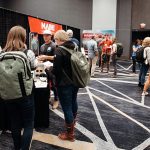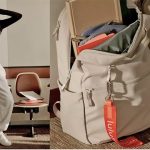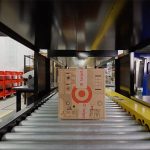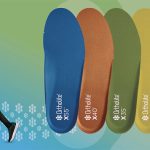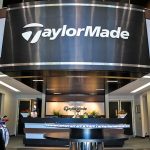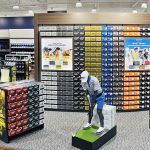Helen of Troy, the parent of the Hydro Flask and Osprey outdoor brands and the Oxo kitchenware brand, saw its HELE shares fall nearly 12 percent on Thursday, April 24, to close at $30.04 as the company withheld fiscal 2026 guidance and said it was pausing shipments of goods coming out of China.
The company, which owns a portfolio of consumer brands, is using China for far more production beyond any goods designated for the U.S. outdoor and sporting goods market but expects the majority of its China production to move by the end of the year.
On a conference call with analysts on Thursday, company CEO Noel Geoffroy addressed the elephant in the room right out of the chute.
“The scope, severity, speed, and daily changes to global trade policy are creating significant uncertainty and disruption to our business, and all indicators suggest we will see a meaningful impact to consumer behavior,” Geoffroy began on the call.
“As a result, until we have more clarity, we are not in a position to provide fiscal 2026 guidance at this time, and we are also stepping back from the long-term algorithm we laid out at our Investor Day in October 2023,” Geoffroy detailed.
“We are proud to have many brands that hold leadership positions across multiple categories and that continue to earn consumer and industry recognition for their outstanding quality and performance,” the CEO commented. “As a result of our recent actions to reset and revitalize our business, we strengthened our brand fundamentals, increased our growth investment and expanded our brand’s distribution.”
Geoffroy noted that, as in prior recessionary periods, many of the company’s brands resonate well during economic downturns as they offer value to consumers looking to stretch their budgets.
“First, let me start with the actions we have already taken in response to the tariffs as they stand today. We are focusing on controlling our controllables while continuing to monitor the landscape closely,” the CEO said.
“For the moment, we have paused certain purchases from China that were destined for the U.S. market and will rely on our current inventory to meet short-term demand,” Geoffroy detailed. “Recall, we purchased targeted additional inventory in late fiscal 2025 and early fiscal 2026, ahead of tariffs. That will help us now.”
CFO Brian Grass said the company is pausing all China purchases in the short term with a few exceptions and expects over 60 percent of U.S.-bound goods to be sourced outside China by the end of fiscal 2027.
“This will allow us to evaluate and adapt to further trade policy developments and minimize the overall tariff impact in the event there is a reversion back to a more normalized global trade posture in the near future,” Grass noted.
“In light of the size of current China tariffs, the estimated tariff impact that we will not be able to directly mitigate, and the expectation of cascading impacts on the economy and consumer, we are taking additional actions to reduce other operating costs, optimize the balance sheet, maximize cash flow and accelerate debt paydown. With these actions and the tariff mitigation strategies referred to earlier, we believe we can offset 70 percent to 80 percent of the tariff impact in fiscal 2026 based on tariffs currently in place,” Grass detailed.
“We expect to make meaningful progress by the end of fiscal 2026,” Geoffroy stated.
Additional steps include:
- HELE accelerated its multi-year risk mitigation plan to further diversify its supply chain outside of China and expects to make meaningful progress by the end of fiscal 2026. The company refreshed its SKU prioritization with the latest data to allocate purchases and efforts toward the most promising and profitable opportunities.
- HELE is evaluating pricing and promotional plans across its portfolio in close partnership with retailer partners. The company is also evaluating its marketing spend and will leverage its marketing mix modeling capability to optimize investment in brands and programs with the highest ROI and relevance in the current environment.
- HELE made targeted organizational changes to manage costs and improve focus in key areas, including strengthening its innovation capability in Beauty & Wellness and aligning its supply chain and IT organizations to support its current priorities. The company has increased its focus on controlling cost and capital expenditures across the organization.
“Importantly, as a result of Project Pegasus, we are now operating with a more efficient foundation, both through reduced cost of goods and a more centralized data-driven organizational structure,” Geoffroy offered. “Finally, we are leaning into areas of opportunity, including international, which is not subject to tariffs, as well as value reframing across our portfolio.”
Geoffroy said the company believes that consumers will become even more cautious with their spending, and many of its leading brands are well-positioned to offer consumers the benefits they seek at a great value. She also noted that as consumers choose to eat out less, OXO is a go-to for at-home cooking and coffee, while PUR can save consumers up to $75 every month when they switch from bottled water to a PUR system.
Looking at the fourth quarter, the CEO called out Osprey, OXO, Wellness, and International, which grew 5.6 percent year-over-year in Q1 and better-than-expected contribution from Olive & June.
Geoffroy said the company increased its U.S. weighted distribution by approximately 12 percent year-over-year, making its brands increasingly available where consumers shop.
“We are encouraged by the progress we’ve made and believe these steps have strengthened our position to navigate fiscal 2026 and beyond,” Geoffroy stated.
Home & Outdoor Segment
For the Home & Outdoor segment, which includes Osprey, Hydro Flask and OXO, the company reported segment growth was driven by continued strong performance at Walmart and on Amazon.
Home & Outdoor segment net sales revenue decreased 1.6 percent to $219.8 million in the fourth quarter ended February 28, compared to $223.3 million in the prior-year quarter. The company said the decline was driven by the insulated beverageware category, partially offset by growth in packs and the home category.
The decrease was reported primarily due to continued competitive intensity in the insulated beverageware category, softer overall consumer demand, lower replenishment orders from retail customers, decreased closeout channel sales, and lower club sales in the home category. These factors were partially offset by higher international sales across all categories, increased online channel sales in the home category, and new and expanded retailer distribution in the insulated beverageware and home categories.
Home & Outdoor segment operating income was $32.3 million, or 14.7 percent of segment net sales revenue, in the fourth quarter, compared to $35.0 million, or 15.7 percent of segment net sales revenue, in the prior-year fourth quarter. The 100 basis point decrease in segment operating margin was primarily due to a less favorable product and customer mix and an increase in restructuring charges of $2.6 million. These factors were partially offset by lower commodity and product costs, favorable inventory obsolescence expenses, lower annual incentive and share-based compensation expenses.
Segment Adjusted operating income decreased 5.8 percent to $39.3 million, or 17.9 percent of segment net sales revenue, compared to $41.7 million, or 18.7 percent of segment net sales revenue, in the prior-year Q4 period.
The CEO said OXO’s product quality and functionality continue to attract new consumers, with nearly 90 percent of Walmart OXO Kitchen utensil consumers being first-time buyers of the brand.
Osprey also grew in the quarter, with performance driven by strong growth in international and direct-to-consumer (DTC).
“While the U.S. tech pack category remains soft, Osprey continues to hold a strong No. 1 position over two times the size of the next national brand,” Geoffroy claimed. “Osprey also continued to gain share in the adjacent everyday lifestyle pack and kid carrier pack categories.”
At Hydro Flask, the company reportedly continues to see the overall insulated beverage category slowing with some shift away from travelers and back into bottles. The brand reportedly continued to expand its presence in Target into the sporting goods section, with an assortment of drinkware, soft coolers and lunch boxes.
The brand reportedly did an initial U.S. DTC launch of a 7.6-ounce Micro Hydro that captured buzz subsequent to quarter end. Geoffroy noted that the launch included three DTC-only drops that sold out within hours, with consumers waiting for the next drop.
“The Micro Hydro was initially designed for the Japanese market primarily to carry hot water for tea or on-the-go soup while also tapping into the fashion trend-setting consumer,” the CEO offered. “We launched in Japan in February to strong reception, more than doubling our initial forecast. We are pleased that Micro Hydro Flask is now also successfully capturing the interest of U.S. consumers who love it for both its functionality and its irresistible aesthetic.”
Geoffroy said the Micro Hydro also became a New York Fashion Week accessory.
Full-Year Home & Outdoor
Looking at the fiscal year for Home & Outdoor as a whole, the CEO said they were pleased with the performance of OXO, particularly the distribution gains and strong performance at Walmart, as well as growth online and internationally.
Hydro Flask continues to broaden its appeal and relevance with size and form innovations like travel bottles, and now Micro Hydro is used to meet different usage occasions and deliver share growth in the Travel Tumbler segment. The company noted that it continues to introduce on-trend seasonal colors and designs consumers desire; the latest is a vibrant limited-edition jelly collection launched in March.
International was also said to be a bright spot where the Hydro Flask brand leveraged the Home & Outdoor channel distribution strength. International was also a bright spot for Osprey in fiscal 2025, particularly in APAC and EMEA.
“As I touched on a bit earlier, International was again a standout in the quarter, with sales outperforming our expectations,” Geoffroy said. “Growth was broad-based across all key geographic markets and segments with particular strength in Osprey and Hydro Flask; this caps off a strong year for our international business, which grew 5.3 percent in fiscal 2025. As mentioned, we intend to lean into international opportunities even more in fiscal 2026.”
Fourth Quarter 2025 Executive Summary
(Fourth Quarter of Fiscal 2025 compared to Fiscal 2024)
- Consolidated net sales revenue of $485.9 million compared to $489.2 million;
- Gross profit margin of 48.6 percent compared to 49.0 percent;
- Operating margin of 0.4 percent, which includes non-cash asset impairment charges of $51.5 million, compared to 13.5 percent;
- Non-GAAP adjusted operating margin of 15.4 percent compared to 17.0 percent;
- GAAP diluted EPS of $2.22 compared to $1.79;
- Non-GAAP adjusted diluted EPS of $2.33 compared to $2.45;
- Net cash provided by operating activities of $35.0 million compared to $73.6 million; and
- Non-GAAP adjusted EBITDA margin of 17.4 percent compared to 19.3 percent.
Full-Year 2025 Executive Summary
(Fiscal 2025 compared to Fiscal 2024)
- Consolidated net sales revenue of $1.908 billion, a decrease of 4.9 percent;
- Gross profit margin improvement of 60 basis points to 47.9 percent compared to 47.3 percent;
- Operating margin of 7.5 percent compared to 13.0 percent;
- Non-GAAP adjusted operating margin of 13.2 percent compared to 15.0 percent;
- GAAP diluted EPS of $5.37 compared to $7.03;
- Non-GAAP adjusted diluted EPS of $7.17 compared to $8.91;
- Net cash provided by operating activities of $113.2 million compared to $306.1 million; and
- Non-GAAP adjusted EBITDA margin of 15.2 percent compared to 16.8 percent.
Balance Sheet and Cash Flow
(Fiscal 2025 compared to Fiscal 2024)
- Cash and cash equivalents totaled $18.9 million, compared to $18.5 million;
- Accounts receivable turnover was 71.5 days, compared to 66.2 days;
- Inventory was $452.6 million, compared to $396.0 million;
- Total short- and long-term debt was $916.9 million, compared to $665.7 million;
- Net cash provided by operating activities for fiscal 2025 was $113.2 million, compared to $306.1 million; and
- Free cash flow for fiscal 2025 was $83.1 million, compared to $269.4 million.
Pegasus Restructuring Plan
The company previously announced a global restructuring plan to expand operating margins through initiatives designed to improve efficiency and effectiveness and reduce costs, collectively called Project Pegasus.
Project Pegasus includes multiple workstreams to further optimize the company’s brand portfolio, streamline and simplify the organization, accelerate and amplify cost of goods savings projects, enhance the efficiency of its supply chain network, optimize its indirect spending, and improve its cash flow and working capital, as well as other activities. These initiatives created operating efficiencies and provided a platform to fund growth investments.
During the fourth quarter of fiscal 2025, the company completed Project Pegasus, which resulted in total pre-tax restructuring charges of $60.9 million, of which $18.7 million was recognized in Home & Outdoor and $42.2 million in Beauty & Wellness. Total pre-tax restructuring charges were slightly above the high end of the company’s range (previously disclosed) of $55 million primarily due to incurring higher severance and employee-related costs, but well below the company’s original expectations of $85 million to $95 million when the project was initiated.
Pre-tax restructuring charges represented primarily cash expenditures and were substantially paid by the end of fiscal 2025, with a remaining liability of $7.7 million as of February 28, 2025, which is expected to be paid during fiscal 2026.
The company continues to have the following expectations regarding Project Pegasus savings:
- Targeted annualized pre-tax operating profit improvements of approximately $75 million to $85 million began in fiscal 2024 and are expected to be substantially achieved by the end of fiscal 2027;
- Estimated cadence of the recognition of the savings will be approximately 25 percent and 35 percent in fiscal 2024 and 2025, respectively, which were both achieved and approximately 25 percent and 15 percent in fiscal 2026 and 2027, respectively; and
- Total profit improvements to be realized approximately 60 percent through reduced cost of goods sold and 40 percent through lower SG&A.
Fiscal 2026 Business Update
Due to evolving global tariff policies and related business and macroeconomic uncertainty, the company said it is not providing an outlook for fiscal 2026 at this time. The company is assessing the incremental tariff impact in light of continuing changes to global tariff policies, the full extent of its potential mitigation plans, and the associated timing to fully execute such plans in a rapidly changing macro environment.
To mitigate the company’s risk of ongoing exposure to tariffs, it has intensified efforts to diversify its production outside of China into regions where it expects tariffs, or overall costs, to be lower and to source the same product in more than one region, to the extent it is possible and not cost-prohibitive.
The company expects to reduce its cost of goods sold exposed to China tariffs to less than 20 percent by the end of fiscal 2026. The company continues to assess and implement other mitigation actions, which include cost reductions from suppliers and price increases to customers.
While the company has not yet made all its pricing decisions, price increases are being considered, along with other mitigation strategies.
In addition to the uncertainty from evolving global tariff policies, the company believes there is a high probability of unfavorable cascading impacts on inflation, consumer confidence, employment, and overall macroeconomic conditions that are impossible to predict at this time and outside the company’s control.
Out of an abundance of caution and in expectation of a complex and uncertain environment, the company is implementing several measures to reduce costs and preserve cash flow that will remain in place until there is greater certainty and less variability, which include the following:
- Suspension of projects and capital expenditures that are not critical or in support of supplier diversification or dual-sourcing initiatives;
- Reduction and deferral of marketing, promotional and new product development expenses;
- Actions to reduce overall personnel costs and pause most project and travel expenses;
- A freeze on inventory purchases from China in the short term, except purchases supporting key launches already underway, and an overall reduction in inventory purchases in expectation of softer consumer demand in the short to intermediate term; and
- Actions to optimize accounts receivable and payable days outstanding.
Based on current tariffs, the company believes it can offset 70 percent to 80 percent of the tariff impact in fiscal 2026 through the combination of tariff mitigation actions and these additional cost reduction measures.
CFO Grass closed his prepared remarks with some transparency to fiscal 2026 first-quarter estimates.
“Lastly, to help with modeling, I want to remind everyone that our first quarter is typically our lowest revenue quarter. The seasonality of our portfolio and retailer ordering patterns have evolved over the past few years, which has caused even more contraction in the first quarter. We expect this trend to further exacerbate in fiscal 2026,” Grass said.
“We are also expecting an unfavorable impact from retailers who have paused our direct import shipments from China to avoid the current level of tariff, which we expect to have an impact on our first quarter revenue. Finally, we are expecting a decline in international revenue in the first quarter due to lower revenue from China, driven primarily by trade tensions,” Grass closed.
Image courtesy Osprey/Helen of Troy Limited



